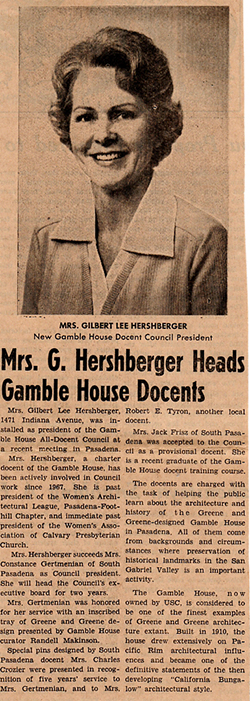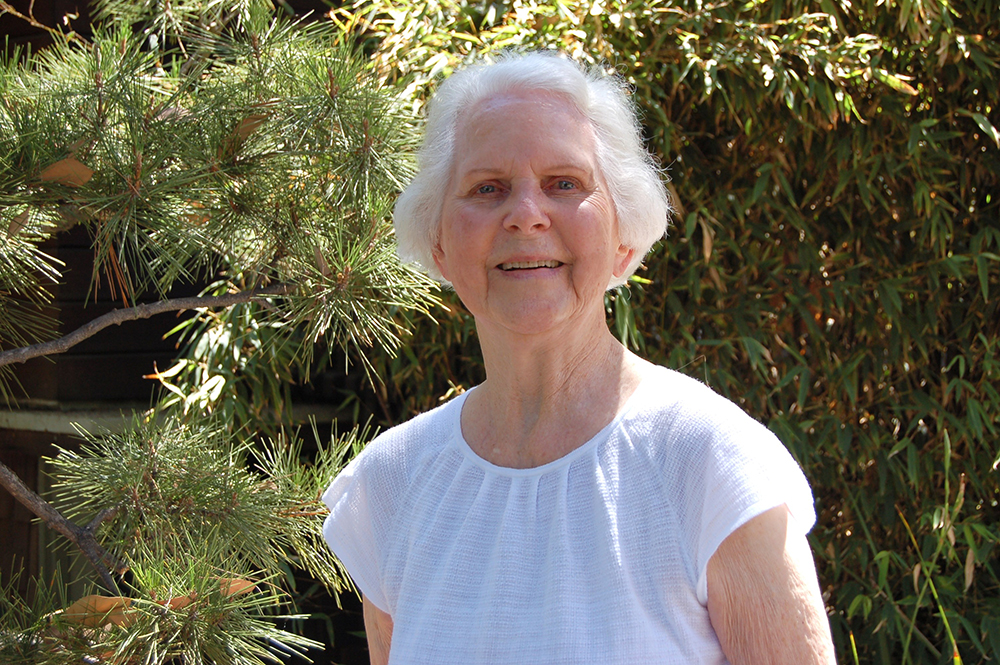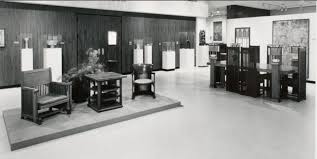OUR STORY THROUGH THEIR EYES: GLENICE HERSHBERGER

By Lisa Reitzel, Gamble House History Committee
Imagine that The Gamble House is, well, just a house. Suddenly it’s changing from a drive-by curiosity to a walk-in destination—and you’re among the handful of people who need to make that happen.
That was the challenge Glenice Hershberger faced as she and a group of Pasadena-area women agreed to serve as the first Gamble House Docents.
It was September 25, 1966—a period hardly known for revering the past. Brutalism, harvest gold, and “urban renewal” reigned. The House had just passed from preservation-minded Gambles to the city of Pasadena in partnership with the University of Southern California, and it was time to embrace the public’s fascination with 4 Westmoreland Place and open it for tours.
Randell Makinson, then Gamble House Curator and later Director, requested that the local Women’s Architectural League meet at the House to launch a mystery mission. “We were told there was so much interest in seeing the House and Mr. Gamble was willing and wanting to have it available for people to enjoy,” Glenice recalled. And this group—wives of local American Institute of Architects members—was just the one for the job.
INTO THE UNKNOWN
The charter Docent Council began leading tours two days a week in early 1967 and formally completed its on-the-job training that June (see related newspaper announcement “Docents Receive Charter”). The pressure was on. “James Gamble said he lost sleep over it. He didn’t know whether it would work or not,” Glenice said.
Success was immediate and gratifying. “People were amazed. It was beautiful—they felt very privileged to be able to come in and see it,” she said. “Early on we didn’t charge anything. And it was very painful when we had to charge a dollar.”
The Docent Council operation was learn-as-you-go. Meetings were held on Living Room rugs and around the Dining Room table, chairs were carried to the lawn for cleaning, dishes from the Pantry were used at special events, and overnight guests created a steady stream of comings and goings. “We did everything before we learned better, which was right and which was wrong for the preservation of the House,” she said.
But the team quickly hit its stride, developing many programs that are hallmarks today. “We learned by visiting other historic properties—including a trip to Chicago,” Glenice explained. “It was almost like an ’SC education.”
Their innovations were far-sighted and long-lasting:
- “Schools program” (grew into Junior Docents leading tours for other young students)
- Scholars in Residence (“Everybody was worried about security in the House”—a study concluded that “having people here” was the best solution.)
- Wednesday Luncheons (served on the Terrace to engage potential Docents)
- Floral arrangements (created in the Pantry sink)
- Docent Library (sprang from two books in Mr. Gamble’s Den)
- Rose & Crane Society for Past Presidents (“I came up with that name,” which sounded pub-like to some. “Everyone thought we were a drinking society.”)
- And yes, the booties (“It was the era of skinny little heels” and faint indents were appearing in the floors. Hand-knit slip-ons were the cleverly homespun answer.)
Along the way came skills to manage emergencies (earthquakes and a visitor’s heart attack), celebrity guests (the Duke of Edinburgh during the ’84 Olympics and a female ambassador for the Shah of Iran), Hollywood (“Back to the Future” film crew), and the occasional haunting (often the last person to leave the House, she was looking in on the Master Bedroom “and the mirror tipped—we did not have anything happen that made it do that”).
A LEGACY THAT LASTS
Nearly 50 years later, the all-volunteer Docent Council serves as a model to house museums throughout the world. “It’s tremendous. It’s gone way beyond what anybody expected,” Glenice said.
She’s proud of her accomplishments as President (1975-76) but modestly highlights the practical. “Well, we got refrigerators” (housed in the cold room off the Kitchen as lunch breaks were taken on the enclosed porch). She celebrates “the joy of being a part of it, and of the architecture because of a connection to architecture, the people—my good friends.”
A recent walk-through of the House revealed her compelling mix of authority and wonder that surely mesmerized tourgoers. She called out the beauty of the House along with its functionality, creating a fully formed diorama inside the redwood shingles. But that’s just her style. “Everybody can make it whatever they feel like making it,” she said.
Her philosophy is simple: “The House will tour itself.” Even the newest Docent can lead with ease. Every room, she said, is the prompter. “Just set your eyes on something and talk about it.” Brevity ruled then just as it does now. “We weren’t supposed to tell everything we knew. They don’t care that much [which Scholar in Residence] had spaghetti or not.”
She cherishes the many friends she made in that early tight-knit group and throughout the years. “It’s like a family and it’s an honor to be asked to be a Docent,” she said. “I figure I’ve had three homes: the home I live in, my church, and The Gamble House.”
About Glenice
Glenice Hershberger was born in South Pasadena and proudly proclaims she may well be the city’s longest-term (not oldest!) resident.
Her love of great design begins at home—a building created by her husband, Gilbert “Lee” Hershberger, who graduated from the USC School of Architecture and practiced with Smith & Williams in South Pasadena. The couple, whose paths first crossed in eighth grade (“We never met, we just grew up together”), married in 1948 and have one daughter, Diane.
On the heels of South Pasadena High School, Glenice attended the Sawyer School of Business in Pasadena. She worked in the South Pasadena City Attorney’s office and for a fiberboard manufacturer in Vernon before her daughter was born. After her year as Docent Council President, she hired on as an administrative assistant to then-Director Randell Makinson, working in an office in the House’s 2nd-floor Guestroom.
Her Docent Council service also includes being Co-Chairperson for the Book Sales and Docent Training committees. She has contributed to several area organizations: the Women’s Architectural League of Pasadena–San Gabriel Valley, Calvary Presbyterian Church, and local schools.



Leave a Reply